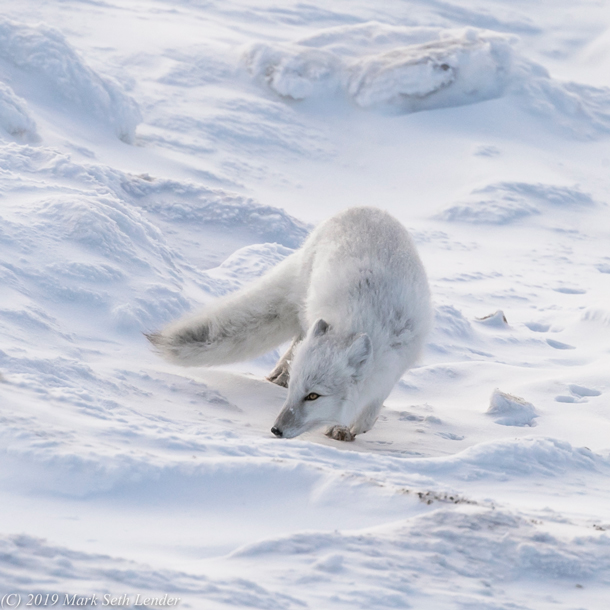Field Note: Arctic Fox Hunting
Published: October 18, 2019
By Mark Seth Lender

In the stark whiteout of an Arctic winter, animals like the Arctic Fox must use all their senses to survive. (Photo: Mark Seth Lender)
Living on Earth’s Explorer in Residence Mark Seth Lender reflects on his experience of watching an Arctic fox on the hunt.
Tundra Buggies are huge and white and unforgivably intrusive machines (or so I always thought). For years I wouldn’t have anything to do with them. I was wrong. No Arctic predator lives past the age of twenty, Tundra Buggies have been prowling Churchill Point twice that long. No animal alive has known a time when they did not exist as a permanent and predictable part of the landscape. They never stray off road and above all no one aboard shoots the wildlife other than with a camera. In a Tundra Buggy you are well and duly ignored and free to observe at close proximity.
Arctic Fox looked straight at me, more than once, and in some way as in any interaction this must have altered his behavior, if only as a pause in routine. That his hunt was not successful is another matter. I did not see him catch a single thing. He should have.
There were silver foxes in the area, and I also saw them hunting, with evident and repeated success. A clear intrusion on the range of Arctic foxes especially in November. The larger problem lay in what at least one silver fox was hunting besides voles: Arctic foxes. A few days before I arrived a silver fox had been observed killing and eating an Arctic fox kit. The day after I left an adult Arctic fox was killed and eaten. This individual was not the one described here but another I had photographed. She had a vertical scar that ran from the ridge of the eyebrow to below the eye socket and while the eye itself looked to be intact, maybe it wasn’t. She was relatively thin, an indicator of sexual dimorphism or age perhaps, or hunting skill. An adult silver fox is bigger and stronger than any Arctic fox, thin or fat.
Arctic foxes cannot go further north where in winter they could not survive. And they cannot stay.
Listen to Mark Seth Lender read his Arctic Fox Hunting essay
Mark Seth Lender’s stay in Churchill was hosted by Frontiers North, the inventors of the Tundra Buggy. Mark’s fieldwork and travel are arranged by Destination: Wildlife.
Back to Mark Seth Lender Field Notes
Living on Earth wants to hear from you!
Living on Earth
62 Calef Highway, Suite 212
Lee, NH 03861
Telephone: 617-287-4121
E-mail: comments@loe.org
Newsletter [Click here]
Donate to Living on Earth!
Living on Earth is an independent media program and relies entirely on contributions from listeners and institutions supporting public service. Please donate now to preserve an independent environmental voice.
NewsletterLiving on Earth offers a weekly delivery of the show's rundown to your mailbox. Sign up for our newsletter today!
 Sailors For The Sea: Be the change you want to sea.
Sailors For The Sea: Be the change you want to sea.
 The Grantham Foundation for the Protection of the Environment: Committed to protecting and improving the health of the global environment.
The Grantham Foundation for the Protection of the Environment: Committed to protecting and improving the health of the global environment.
 Contribute to Living on Earth and receive, as our gift to you, an archival print of one of Mark Seth Lender's extraordinary wildlife photographs. Follow the link to see Mark's current collection of photographs.
Contribute to Living on Earth and receive, as our gift to you, an archival print of one of Mark Seth Lender's extraordinary wildlife photographs. Follow the link to see Mark's current collection of photographs.
 Buy a signed copy of Mark Seth Lender's book Smeagull the Seagull & support Living on Earth
Buy a signed copy of Mark Seth Lender's book Smeagull the Seagull & support Living on Earth

